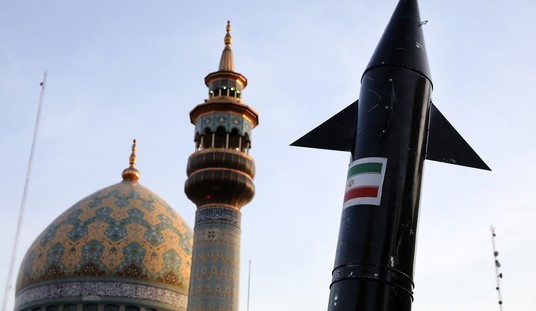Writing today in The New York Post, Amir Taheri — the distinguished Iranian-born journalist — manages to move the debate over the so-called “Ground Zero mosque” forward several notches. Anyone who wants to understand what is at stake in the project — anyone at home Mayor Forever Bloomberg? — should read it.
I’ll come back to Mr. Taheri in a moment. First, a word or two about how this act of effrontery ought to be opposed.
Regular readers know that I oppose the project. They also know that I regard the effort by President Obama and others to frame the debate in terms of a First-Amendment right to religious freedom as profoundly misguided. The issue is not whether Muslims have the right to build mosques in America. There are thousands of the things from coast to coast. The issue is rather the appropriateness of building a mosque directly adjacent to Ground Zero, a spot rendered forever sacred by the heedless slaughter of 3000 innocent people by Muslim fanatics.
I know that “appropriateness” may seem like a weak word for what is, after all, a visceral, hot-button issue. But in fact, the controversy over whether Imam Rauf should be allowed to build the mosque is a controversy whose settlement belongs not to the realm of positive law but rather to that more variegated realm that Lord John Fletcher Moulton, a British judge, forcefully described almost 100 years ago in “Law and Manners.” “There is,” Lord Moulton observed, “a widespread tendency to regard the fact that [one] can do a thing as meaning [one] may do it. There can be no more fatal error than this. Between ‘can do’ and ‘may do’ ought to exist the whole realm which recognizes the sway of duty, fairness, sympathy, taste, and all the other things that make life beautiful and society possible.” One of the most destructive aspects of our culture has been the evisceration of that middle ground of “duty, fairness, sympathy, taste,” etc. — everything that Lord Moulton congregated under the memorable category of “obedience to the unenforceable.”
The same sort of consideration, by the way, applies to Terry Jones, the Florida “pastor” who is about 13 minutes into his fifteen minutes of fame for announcing he plans to burn a couple hundred copies of the Koran tomorrow. As Andy McCarthy reminded us, the technical term for the Rev. Jones (“Rev.” as in “Rev. Al Sharpton”) is “nincompoop.” He shouldn’t burn the books. But not because he doesn’t have the emright/em to do so. Rather, he shouldn’t do it because it would be grossly inappropriate, outrageous, and generally would be in very bad taste. It would be a pity if the force of such interdictions were lost in our litigious age, when more and more people, as Moulton warned, deliberately elide the propositions “it can be done” with “it may be done.”
But what of the prior question, the meaning, the intention of the Cordoba House project — what is it? Here is where Amir Taheri sheds some important light.
Imam Rauf, when he talks to you or me or Mayor Forever Bloomberg, tells us he is all about dialogue, tolerance, mutual understanding, etc. I believe Andy McCarthy and other have put that subterfuge to rest. Amir Taheri adds some clarifying historical context. “The proposed structure,” Taheri observes, “is known in Islamic history as a rabat — literally a connector. The first rabat appeared at the time of the Prophet.”
The Prophet imposed his rule on parts of Arabia through a series of ghazvas, or razzias (the origin of the English word “raid”). The ghazva was designed to terrorize the infidels, convince them that their civilization was doomed and force them to submit to Islamic rule. Those who participated in the ghazva were known as the ghazis, or raiders.
After each ghazva, the Prophet ordered the creation of a rabat — or a point of contact at the heart of the infidel territory raided. The rabat consisted of an area for prayer, a section for the raiders to eat and rest and facilities to train and prepare for future razzias. Later Muslim rulers used the tactic of ghazva to conquer territory in the Persian and Byzantine empires. After each raid, they built a rabat to prepare for the next razzia.
So much for ancient history. Pay attention, now, for Taheri brings the story up to date:
It is no coincidence that Islamists routinely use the term ghazva to describe the 9/11 attacks against New York and Washington. The terrorists who carried out the attack are referred to as ghazis or shahids (martyrs).
Thus, building a rabat close to Ground Zero would be in accordance with a tradition started by the Prophet. To all those who believe and hope that the 9/11 ghazva would lead to the destruction of the American “Great Satan,” this would be of great symbolic value.
Got it? “Great symbolic value”: and what is the symbolism? There is a short, two-word Anglo Saxon imperative beginning with the letter “F” and ending with “You” that about sums it up, but Taheri is too decorous to put it thus. Instead, he dilates on the mendacious evasion of Imam Rauf’s proclamation that “Cordoba House” would be a tribute to tolerance and this year’s equivalent of Godot, “moderate Islam.” “Faced with the anger of New Yorkers,” Taheri notes, “the promoters of the project have started calling it the Cordoba House, echoing President Obamas assertion that it would be used to propagate ‘moderate’ Islam.”
The argument is that Cordoba, in southern Spain, was a city where followers of Islam, Christianity and Judaism lived together in peace and produced literature and philosophy.
In fact, Cordoba’s history is full of stories of oppression and massacre, prompted by religious fanaticism. It is true that the Muslim rulers of Cordoba didn’t force their Christian and Jewish subjects to accept Islam. However, non-Muslims could keep their faith and enjoy state protection only as dhimmis (bonded ones) by paying a poll tax in a system of religious apartheid.
If whatever peace and harmony that is supposed to have existed in Cordoba were the fruit of “Muslim rule,” the subtext is that the United States would enjoy similar peace and harmony under Islamic rule.
Thanks a lot! Peace, harmony, and subjugation. Taheri ends with a sage bit of advice: “Before deciding whether to support or oppose the ‘Cordoba’ project, New Yorkers should consider what it is that they would be buying. Caveat emptor, schmuck.








Join the conversation as a VIP Member